Essay in NBR Special Report 118
China’s Slowing Economic Growth
Causes and Impacts
This chapter analyzes China’s economic slowdown and considers the implications of the country’s growth trajectory for its trade and investment partners.
EXECUTIVE SUMMARY
MAIN ARGUMENT
Over the past decade, China has seen a steady decline in its real GDP growth rate. This rate has declined from an average of 10% in 1980–2012 to around 7% in the seven years preceding the Covid-19 pandemic (2013–19) and to less than 5% in the years since China exited the pandemic. Many independent forecasts suggest that the Chinese economy will continue to slow in the coming years. The International Monetary Fund, for instance, projects that the country’s real growth rate could slow to around 3% by 2030. China’s economic slowdown results from a mix of structural factors (such as demographics and the exhaustion of returns from infrastructure spending) and policy choices related to both long-term development strategy and short-term macroeconomic management. Under current policy conditions, China will probably record 4%–5% real GDP growth in 2025–26, falling to 3%–4% thereafter. There is little chance of macro policy becoming dramatically more stimulative. Deflationary pressure will likely persist, resulting from both the impact of the property sector collapse and the government’s policies of increasing the supply of manufactured goods while doing little to support aggregate demand. As a result, nominal growth will not be much stronger than real growth.
POLICY IMPLICATIONS
- Sluggish growth will not prevent China’s manufacturing sector from thriving, particularly given the government’s industrial policies and the country’s rising share in global export markets. Protectionist efforts to reduce the flow of Chinese exports in global markets will struggle to reverse this trend.
- China could achieve much stronger growth results with a more stimulative policy mix, including greater support for the property sector; interest rate cuts and currency depreciation; more fiscal spending to boost aggregate demand; and service-sector deregulation.
- China’s investment and trade partners will need to contend with an economy whose demand for imports is sluggish and increasingly skewed away from manufactures toward commodities and other inputs, while the country’s exports are increasingly competitive on global markets. Successful responses will require tapping into China’s shifting patterns of commodity demand and extracting maximum advantage from its outbound direct investment flows.
Arthur R. Kroeber is Partner and Head of Research at Gavekal Dragonomics and an Adjunct Professor of Economics at the NYU Stern School of Business.


